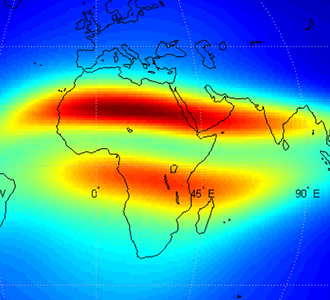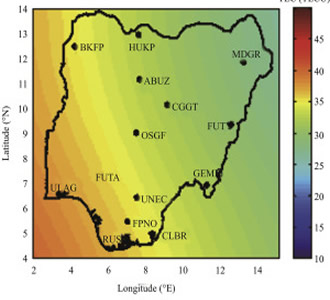Space weather refers to the conditions in space environment that have impact on space-dependent technological systems. Space weather deals with the interactions of ambient radiation & matter within interplanetary, and occasionally interstellar space.
Space-dependent technologies are technologies which depend on use of satellites that are in orbits. Space weather is fast becoming a global concern. Today’s world is driven by space-dependent technologies. Communication-, satellite-, navigational-, aviation-, and Information technologies, are some of the mostly patronized space-dependent technologies in the world today. Virtually all human’s industries depend are on space-dependent technologies.
Space weather effects on satellites include surface and deep dielectric charging, single event upsets, spacecraft drags, accumulating dose effects, solar radio frequency interference and scintillation, photonic noise, spacecraft orientation effects, spacecraft imaging and attitude systems, materials degradation etc. The functionality and efficiency of all space-dependent technologies are prone to space weather hazards.
The International Space Weather Initiative (ISWI) of the United Nations Committee on the Peaceful Uses of Outer Space was launched in 2009 and formally concluded as an agenda item of the Committee in 2012. However, ISWI activities continued and since 2013 are discussed under the new permanent agenda item on Space Weather in the Scientific and Technical Subcommittee of the Committee. The UN-ARCSSTEE being one of the UN Regional Centres for Space Science and Technology Education serve as informational dissemination Centre for the United Nations Office for Outer Space Affairs that is anchoring the International Space Weather Initiative. Space Weather is this is one of the activities of the UN Regional Centres.
This page offers daily space weather nowcasts and some 3-day forecasts of ionospheric conditions over Nigeria and Africa for global usage.
Daily Space Weather Nowcast and Forecast
Historically, daily space weather nowcasts started appearing on the platform of www.carnasda.com from 16th January 2018 till 13th January 2023 under the management of the NASRDA Centre for Atmospheric Research. Old files can still be retrieved from the page and here as well. Henceforth, due to some administrative restructuring and in a bid to promote regional efficiency the space weather casts shall be found here at the UN Regional Centre’s page. The general public and in particular patrons of space technology-dependent systems/ operations shall benefit tremendously from the space weather now- and forecasts.
Summary of space weather and space weather parameters/observations at the given hours of nowcast and 3-day forecast of daily ionospheric map generated from regional models are as follows:
Space Weather Daily condition
Date: 27 January 2024; 10:06UT
Summary of Space Weather
All of the sunspots on the solar disk have relatively stable magnetic fields.
The geomagnetic conditions are quiet.
The solar wind speed is declining.
Space Weather parameters / observations;
Sunspot Number:97
10.7cm Flux: 157 sfu
Solar wind speed: 387.7 km.s-1
Solar wind density: 4.11 protons.cm3
Kp: 1.33
Bz: -0.48 nT (South)
Bt: 6.44 nT
Dst: -2 nT
Data Source:
Total Electron Content (TEC) Nowcast and Forecast
The TEC Model
The NigTEC gives the forecast of the ionospheric condition over Nigeria while AfriTEC give the forecast over Africa.
Here, TEC is shown in form of spatial maps and vidoes for three days.
This is intended for global usage in ionospheric studies.

Africa GNSS TEC Models
The AfriTEC model is a model of the ionospheric GNSS TEC over the entire African region (Longitudes 25 degree West to 60 degree East, Latitudes 40 degree South to 40 degree North). The model can be used .......

Nigeria GNSS TEC Models
The NIGTEC is a model of the ionospheric GNSS TEC over Nigeria (Longitudes 2-15 degrees East, Latitudes 4-14 degrees North) The model can be used to obtain the ionospheric GNSS TEC at all locations over Nigeria.

